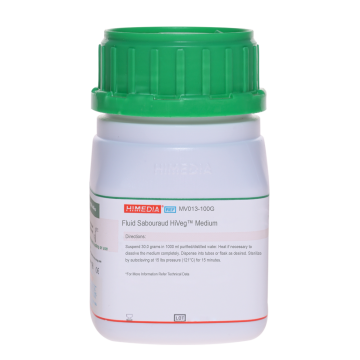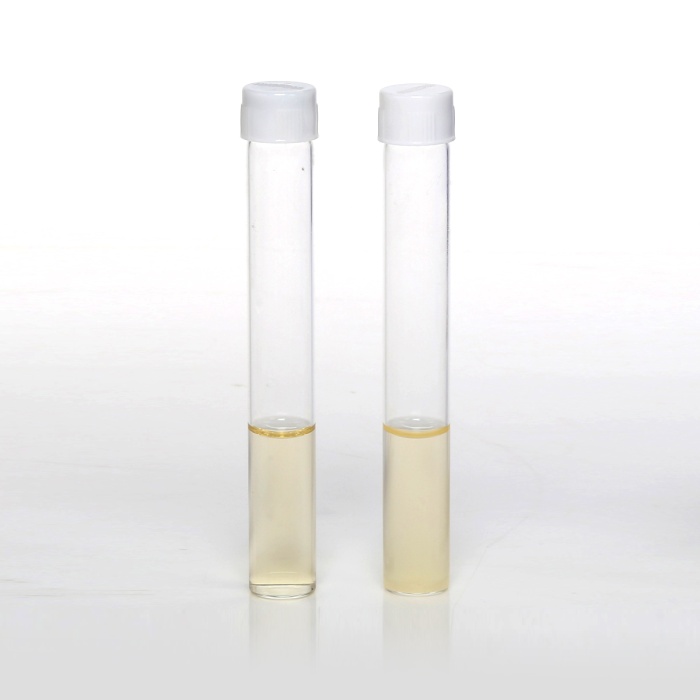 Your enquiry has been submitted
Your enquiry has been submitted
Fluid Sabouraud Medium (Sabouraud Medium, Fluid)
Osmophilic Microorganisms#CC293D
Intended use
Fluid Sabouraud Medium is recommended for use as a sterility testing medium for moulds and lower bacteria in pharmaceutical preparations amples.
Composition**
| Ingredients | g / L |
|---|---|
| Tryptone | 5.000 |
| Peptone | 5.000 |
| Dextrose (Glucose) | 20.000 |
Final pH (at 25°C): 5.7±0.2
**Formula adjusted, standardized to suit performance parameters
Directions
Suspend 30 grams in 1000 ml purified/distilled water. Heat if necessary to dissolve the medium completely. Dispense into tubes or flasks as desired. Sterilize by autoclaving at 15 lbs pressure (121°C) for 15 minutes.
Principle And Interpretation
Fluid Sabouraud Medium is based on the formulation described by Sabouraud (1) for the cultivation of yeasts, moulds, and aciduric microorganisms, particularly useful for the fungi associated with skin infections. It is recommended for use as a sterility testing medium for moulds and lower bacteria. This mycological sterility testing medium is in accordance with USP (2) and the FDA (3) for the determination of fungistatic activity of pharmaceutical products to avoid false sterility tests. The acid reaction of the medium is inhibitory to a large number of bacteria and makes the medium particularly well suited for cultivating fungi and acidophilic microorganisms (3,4,5).
Tryptone and peptone provide nitrogenous and carbonaceous compounds, long chain amino acids, vitamins and other essential nutrients. Dextrose(Glucose) is the energy source. The low pH favors fungal growth and inhibits contaminating bacteria from clinical specimens (5). Some pathogenic fungi may produce infective spores, which are easily dispersed in air, so examination should be carried out in a safety cabinet. For isolation of fungi from potentially contaminated specimens, a selective medium should be inoculated along with the non-selective medium. Incubate at 25-30°C with increased humidity and examine at least weekly for fungal growth and should be held for 4-6 weeks before being reported as negative.
Type of specimen
Pharmaceutical samples.
Specimen Collection and Handling:
For pharmaceutical samples, follow appropriate techniques for sample collection and processing as per guidelines (2).
Warning and Precautions :
Read the label before opening the container. Wear protective gloves/protective clothing/eye protection/ face protection. Follow good microbiological lab practices while handling specimens and culture. Standard precautions as per established guidelines should be followed while handling specimens. Safety guidelines may be referred in individual safety data sheets.
Limitations
- It may not support the growth of all fungi.
- Since the medium is non selective, bacterial cultures may also grow.
- Biochemical test and serological procedures are required to confirm the findings.
Performance and Evaluation
Performance of the medium is expected when used as per the direction on the label within the expiry period when stored at recommended temperature.
Quality Control
Appearance
Cream to yellow homogeneous free flowing powder
Colour and Clarity of prepared medium
Light amber coloured, clear solution without any precipitate
Reaction
Reaction of 3.0% w/v aqueous solution at 25°C. pH : 5.7±0.2
pH
5.50-5.90
Cultural Response
Cultural characteristics observed after an incubation at 25-30°C for 48-72 hours.
| Organism | Inoculum | Growth |
|---|---|---|
| Escherichia coli ATCC 25922 (00013*) | 50-100 | luxuriant |
| Lactobacillus casei ATCC 9595 | 50-100 | luxuriant |
| # Aspergillus brasiliensis ATCC 16404 (00053*) | 50-100 | luxuriant |
| Candida albicans ATCC 10231 (00054*) | 50-100 | luxuriant |
| Saccharomyces cerevisiae ATCC 9763 (00058*) | 50-100 | luxuriant |
Key - (#) Formerly known asAspergillus niger
Key: (*) Corresponding WDCM numbers.
Storage and Shelf Life
Store below 10-30°C in a tightly closed container and the prepared medium at 15-30°C. Use before expiry date on the label. On opening, product should be properly stored dry, after tightly capping the bottle in order to prevent lump formation due to the hygroscopic nature of the product. Improper storage of the product may lead to lump formation. Store in dry ventilated area protected from extremes of temperature and sources of ignition Seal the container tightly after use. Use before expiry date on the label. Product performance is best if used within stated expiry period.
Disposal
User must ensure safe disposal by autoclaving and/or incineration of used or unusable preparations of this product. Follow established laboratory procedures in disposing of infectious materials and material that comes into contact with sample must be decontaminated and disposed of in accordance with current laboratory techniques (7,8).
Reference
- Sabouraud K., 1892, Ann. Dermatol. Syphilol, 3:1061.
- The United States Pharmacopoeia, 2006, USP29/NF24, The United States Pharmacopeial Convention. Rockville, MD
- Food and Drug Administration, 1992, Bacteriological Analytical Manual, 7th Edition. F. D. A Washington, D. C.
- Ajello L., Georg L. K., Kaplan W. and Kaufman L., 1963, Laboratory Manual for Medical Mycology, DHEW Publication No. 994, US Govt. Printing Office, Washington, D.C.
- Murray P. R., Baron E. J., Jorgensen J. H., Pfaller M. A., Yolken R. H., (Eds.), 2003, Manual of Clinical Microbiology, 8th Ed., ASM, Washington, D.C.
- Kavon Chung and Bennett, 1992, Medical Mycology, Lea and Febiger, Philadelphia, Pa.
- Isenberg, H.D. Clinical Microbiology Procedures Handbook 2nd Edition.
- Jorgensen, J.H., Pfaller, M.A., Carroll, K.C., Funke, G., Landry, M.L., Richter, S.S and Warnock., D.W. (2015) Manual of Clinical Microbiology, 11th Edition. Vol. 1.
| Product Name | Fluid Sabouraud Medium (Sabouraud Medium, Fluid) |
|---|---|
| SKU | M013 |
| Product Type | Regular |
| Physical Form | Powder |
| Origin | Animal |
| Packaging type | HDPE |
| References | 1. Sabouraud K., 1892, Ann. Dermatol. Syphilol, 3:1061. 2.The United States Pharmacopoeia, 2006, USP29/NF24, The United States Pharmacopeial Convention. Rockville, MD 3.Food and Drug Administration, 1992, Bacteriological Analytical Manual, 7th Edition. F. D. A Washington, D. C. 4.Murray P. R., Baron E. J., Jorgensen J. H., Pfaller M. A., Yolken R. H., (Eds.), 2003, Manual of Clinical Microbiology,8th Ed., ASM, Washington, D.C. 5.Ajello L., Georg L. K., Kaplan W. and Kaufman L., 1963, Laboratory Manual for Medical Mycology, DHEW PublicationNo. 994, US Govt. Printing Office, Washington, D.C. 6.Kavon Chung and Bennett, 1992, Medical Mycology, Lea and Febiger, Philadelphia, Pa. 7.Isenberg, H.D. Clinical Microbiology Procedures Handb0ook. 2nd Edition. 8.Jorgensen,J.H., Pfaller , M.A., Carroll, K.C., Funke, G., Landry, M.L., Richter, S.S and Warnock., D.W. (2015)Manual of Clinical Microbiology, 11th Edition. Vol. 1. |
| Customized Product Available | No |













